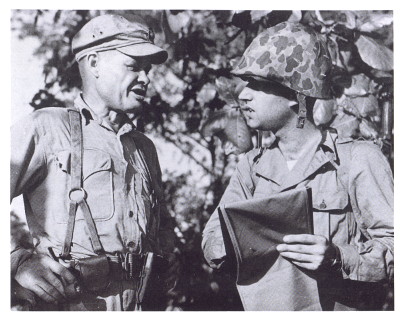 The Island of Peleliu
The Island of PeleliuCol. Lewis 'Chesty' Puller, left, Commanding Officer of my 1st Marine Regiment, 1st Marine Division.
Victory in the Marianas in the summer of 1944 (Tinian, Saipan, and Guam) brought American forces within striking distance of the Philippine Islands and the Japanese home islands. In order to eliminate a possible threat on the right flank of General Douglas MacArthur's intended attack on the Philippines, the Japanese-held Palau Islands were targeted next.
Planning the Invasion of Peleliu
The Palaus are located southeast of the Philippines and 900 miles southwest of Guam, at the western end of the Carolines. The Palaus are an eighty-mile-long island chain, two of which were selected as targets for their potential airfields and relatively weak defenses: Peleliu and Angaur, six miles apart in the southern area of the chain. Both of the low rise volcanic islands were characterized by rough ground with cliffs, sinkholes, coral outcroppings, caves, and thick vegetation. Peleliu was 5Ѕ miles long and 2Ѕ wide with an airfield in the south and a swamp in the east. Three mile long Angaur was similar but much smaller.
The battle for Peleliu was the longest and one of the toughest battles of the Pacific amphibious operations during World War II. Peleliu's defenders drew from lessons of other island campaigns where the Japanese tried and failed to stop the invaders on the beach. At Peleliu, Gen. Inoue's main defensive line was well inland, with indirect fire pre-registered on the beaches, followed by in-depth barriers, caves and pillboxes with fields of fire arranged to thwart and destory any attacker.
The 81st Infantry Division went ashore on Angaur Island, 6 miles south of Peleliu, on 17 September. Beach conditions and opposition were much better than at nearby Peliliu. By 20 September, the 81st had defeated or isolated all of Angaur's 1,400 defenders. The 8lst's commander declared Angaur secure.
Gen. Rupertus preferred Peleliu to be an all-Marine operation, but as casualties grew, on 22 September 1944 the 321st Infantry was transferred to Peleliu. After an artillery barrage and naval gunfire on the hills, the 321st moved inland on 21 September, while a Marine regiment leapfrogged to clear the northern tip of the island. The Army troops found a trail into the hills that they used to split the Japanese into two pockets, one to the south around Umurbrogol ridge, the other to the north. The Umurbrogol pocket proved difficult to overcome because of rough terrain, while, to the surprise of the Americans, General Inoue managed to land 500 fresh troops to reinforce the northern pocket.
The Marines and the Army controlled Peleliu, but the Japanese were far from finished. Japanese troops still held the Umurbrogol Pocket, the complex cave and ridge fortress that was ideal for a fanatic and suicidal defense. Marine infantry, armor, and artillery units hammered the pocket until 15 October, when they were relieved by Army units from the 81st Division. These troops fought a grueling and savage yard-by-yard battle through the jagged hills, the southern slopes of which earned the name "Bloody Nose".
There is a long standing question of whether the losses necessary for the capture of Peleliu were essential. In fact, Admiral William F. Halsey recommended through Admiral Nimitz to the Joint Chiefs of Staff on 13 September 1944, two days before D-Day, that the landing be cancelled. But by that time, it was too late and the invasion went as planned. The Peleliu airfield was useful, not only in support of operations on Peleliu, but as the base for the air defense of the important fleet anchorage established at nearby Ulithi. It will never be settled if Peleliu was worth the cost.
On 21 April 1947, a small band of Japanese holdouts was discovered on Peleliu. They formally surrendered only after considerable effort to convince them the war was over. Lieutenant Yamaguchi, who had maintained military discipline in the group for the intervening years, led 26 soldiers to a position in front of 80 battle-dressed Marines where he turned over his sword.




